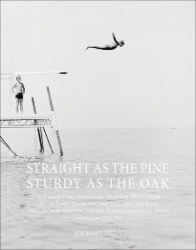Straight as the Pine, Sturdy as the Oak

Straight as the Pine, Sturdy as the Oak
Skipper & Cora Beals and Major & Helen Huey in the Early Years of Camp Leelanau for Boys, the Leelanau Schools, and the Homestead in Glen Arbor. Volume One: 1921-1963
Michael Huey
23 x 28 cm (9 x 11 inch), 496 pages, hardcover approx. 300 illustrations in colour and black/white
2013
ISBN 978-3-902833-38-9
€ 58,00 [A]
€ 56,20 [D]
$ 75,50 [US]
Two sisters from Madison and their adventure-minded husbands boldly create a utopian boys' camp on an idyllic site in the Michigan wilderness in the 1920s. Out of the camp grows an unorthodox boarding school, which, in turn, leads to the founding of a popular summer resort. The three ventures - originally conceived as the "legs of a three-legged stool" - still exist today independently.
Organized along a year-by-year timeline, Straight as the Pine, Sturdy as the Oak follows the arc of change in the peaceful Sleeping Bear Bay region from its late 19th- and early 20th-century fishing/farming beginnings toward the development of the vacation industry that marks it today. (Eventually, the natural beauty of the area leads to the establishment of a national park.) In the initial years, campers and students are taught self-reliance and encouraged to figure things out on their own: in between Latin and history lessons they build boats, study aeronautics, and help grow vegetables and raise animals to feed themselves. At the same time, they are led to see that "they can camp in the woods all summer and still be real gentlemen."
The spirit of learning in and from nature is carried forward into the later years, even when campers, students, and guests no longer arrive by steamer from Chicago. Richly illustrated, the book includes 1920s boys' camp snapshots reminiscent of the world of Thomas Eakins, while its later professional photographs prefigure the work of contemporary artists such as Bruce Weber. Caught in between is the family itself, appearing in staged "private" photos that define their exceptional role as the symbolic, model family to which campers and students belong, but also as the constant thread - from the Twenties through the Sixties - in the history of the camp, the school, and the resort.

